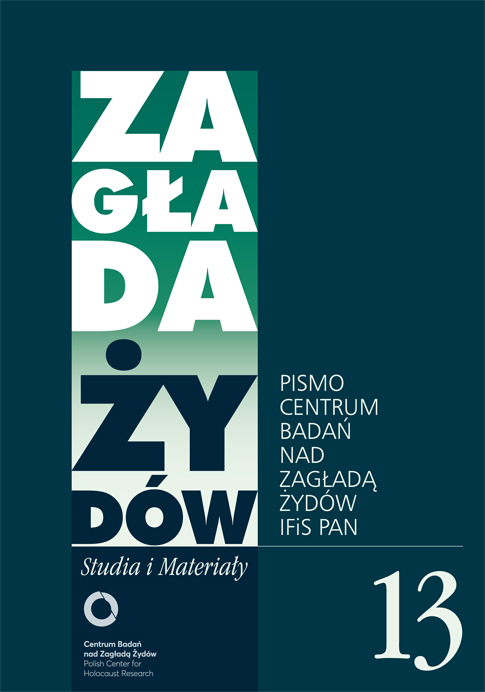Holocaust Reception in Japan. Comparative Analysis: Auschwitz – Nanking – Hiroshima
Zagłada Żydów. Studia i Materiały, No. 13 (2017), Pages: 230-257
Submission Date: 2020-10-17Publication Date: 2017-12-03
 https://doi.org/10.32927/ZZSiM.358
https://doi.org/10.32927/ZZSiM.358
Abstract
This article attempts to present the reception of the Holocaust in relation to the topics of the atomic bombs and Japanese war crimes. Author’s comparative analysis revealed a number of shared issues regarding the war memory mechanisms, and also the characteristic style of Japanese narration centered on the key word ‘peace’. After the testimony period we are slowly entering the post-testimony era, when there will be no living witnesses. But it is also a period which enables researches to conduct a distanced analysis of the political and social discourse on war, particularly regarding Japan, whose post-war historical memory was built with the use of language of ambiguity and omissions. Using the comparative approach makes it possible not only to show the similarity of a number of issues regarding narration about the war, but it also conditions new narrations, which move beyond paradigms of national memory.
License
Copyright (c) 2017 Author&"Holocaust Studies and Materials"

This work is licensed under a Creative Commons Attribution 4.0 International License.
https://creativecommons.org/licenses/by/4.0
The journal is published under the Diamond Open Access Standard, CC-BY-4.0 Deed - Attribution 4.0 International - Creative Commons
Most read articles by the same author(s)
- Ariko Katō, Japanese Publications about the Holocaust Published After 1995 , Zagłada Żydów. Studia i Materiały: No. 14 (2018)
Similar Articles
- Dan Michman, Dutch Society and the Jewish Fate: A Puzzling Record , Zagłada Żydów. Studia i Materiały: No. 12 (2016)
- Jacek Leociak, Understanding the Holocaust. A Task for Generations , Zagłada Żydów. Studia i Materiały: 2008: Holocaust Studies and Materials
- Jacek Leociak, Marta Tomczok, Affective Holocaust Kitsch – Introduction , Zagłada Żydów. Studia i Materiały: No. 17 (2021)
- Stephan Lehnstaedt, Germany and (its) neighbors, or Jedwabne on the western side of the Oder river , Zagłada Żydów. Studia i Materiały: No. 21 (2025)
- Roni Stauber, Philip Friedman and the Beginning of Holocaust Studies , Zagłada Żydów. Studia i Materiały: No. 11 (2015)
- Justyna Kowalska-Leder, The folk history of the Holocaust and the turn to oral history archives , Zagłada Żydów. Studia i Materiały: No. 21 (2025)
- Lior Inbar, We were always Don Quixotes: The Ghetto Fighters’ kibbutz in Israel , Zagłada Żydów. Studia i Materiały: No. 19 (2023)
- Anna Abakunkova, Contemporary Holocaust Studies in Ukraine , Zagłada Żydów. Studia i Materiały: No. 10 (2014)
- Joanna Śliwa, A reviev: Agnieszka Witkowska-Krych, Dziecko wobec Zagłady. Instytucjonalna opieka nad sierotami w getcie warszawskim , Zagłada Żydów. Studia i Materiały: No. 19 (2023)
- Jacek Leociak, Literature of the Personal Document as a Source in Holocaust Research (a Methodological Reconnaissance). , Zagłada Żydów. Studia i Materiały: 2008: Holocaust Studies and Materials
1 2 3 4 5 6 7 8 9 10 11 12 13 14 15 16 17 18 19 20 21 22 23 24 25 26 27 28 29 30 31 32 33 34 35 36 37 38 39 40 41 42 43 44 45 46 47 48 49 50 > >>
You may also start an advanced similarity search for this article.
 English
English
 Język Polski
Język Polski



 https://orcid.org/0000-0002-6298-4303
https://orcid.org/0000-0002-6298-4303





